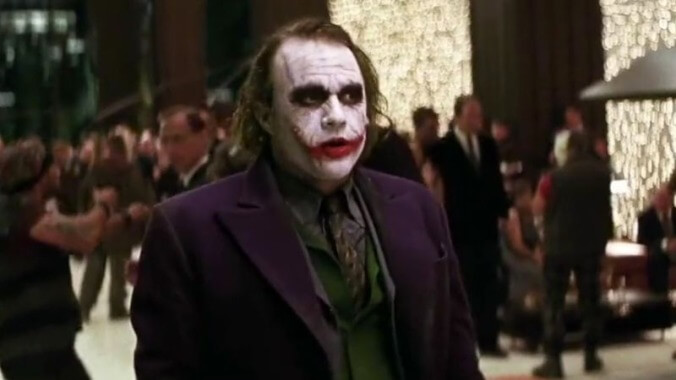The Dark Knight helped spawn a filmmaking boom in Chicago
When Batman Begins shot for a few weeks in Chicago, it was a curiosity. When The Dark Knight set up camp here for months in the summer of 2007, it was a huge deal. The film’s red-herring production name was Rory’s First Kiss, so when The A.V. Club’s Josh Modell ambled up to a production crew member to ask what they were shooting near the office, the guy said “Rory’s First Kiss” with a straight face. A big truck with the words GOTHAM CITY painted on the side drove by right after that.
As much as director Chris Nolan—who grew up in Chicago and London—wanted to keep a low profile while he was shooting, there was no hiding The Dark Knight. Christian Bale stood on the edge of the roof of Sears Tower (now called Willis Tower). A huge chase scene was shot on Lower Wacker Drive. Nolan flipped a truck over on LaSalle Street. Oh, and they blew up a building on the west side.
The Gotham City of Batman Begins looked a lot like it has in other Batman films—dark, grimy, and not obviously Chicago. In The Dark Knight, Nolan didn’t mask the city much; some skyline shots added a bunch of buildings, but it was clearly Chicago. So there was an extra feeling of civic pride when The Dark Knight turned out to be such a great film. Hundreds of films and TV shows had shot here before, but the biggest movie in the world was showcasing Chicago.
And yes, it was a bummer when Nolan decamped to Pittsburgh to make The Dark Knight Rises, but Chicagoans can take consolation in The Dark Knight’s clear superiority over its successor. Five years later, it remains not just the best film of Nolan’s Batman trilogy, but the best Batman film, period. And pop-culture enthusiasts who visit Chicago can see plenty of its locations.
We check out a few of them in this episode of Pop Pilgrims, and we set up in the penthouse ballroom of Wyndham Grand Chicago Riverfront (then called Hotel 71) to talk to Rich Moskal, who runs the Chicago Film Office. (Viewers may remember him from the first season of Pop Pilgrims, when he talked about The Blues Brothers’ insane production.) That ballroom was used as Bruce Wayne’s apartment and for part of the party scene with The Joker. The main location for that scene, though, is an anonymous-looking lobby in an office building at 111 E. Wacker Drive, which the production decorated with a grand stairway and fireplaces. No one would recognize it as is. Another building lobby (this one at 330 N. Wabash Ave.) served as the location for the film’s press conferences and DA’s office. The skeleton of Trump Tower, then still under construction, was used for the SWAT team scene, but the confrontation with The Joker actually took place elsewhere.
Moskal can break down the complicated setups for the various scenes, several of which used different locations for the same scene, depending on which way the camera faced. Over the course of one and a half films, Nolan used just about everything Chicago could offer, which is a big reason why he went to another city for his final Batman film. (Tax incentives helped, too.)
But he also brought Man Of Steel, which he produced, to Chicago a few years later. (Its production name: Autumn Frost.) And The Dark Knight undoubtedly helped other blockbusters choose to film here, such as Transformers 3—whose production made The Dark Knight’s look like Remains Of The Day—and its upcoming sequel, along with Divergent. In a real way, The Dark Knight helped spawn a filmmaking boom in Chicago—at least during the summertime. Even Chistopher Nolan hasn’t tried to come back in January.
